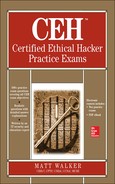
Scanning and Enumeration
This chapter includes questions from the following topics:
• Describing the CEH scanning methodology, scan types, and the objectives of scanning
• Describing the use of various scanning and enumeration tools
• Scan types, such as ping sweep, SYN, stealth, XMAS, NULL, and many more
• Describing TCP communication (three-way handshake and flag types)
• OS fingerprinting through banner grabbing
• Scanning countermeasures
• Enumerating and its techniques
• NULL sessions and their countermeasures
• SNMP enumeration and its countermeasures
• Describing the steps involved in performing enumeration
Have you seen the movie The Waterboy? If I were a film critic, I might say it’s a heartwarming tale of self-discovery involving a young man learning to face his past, present, and future. But the reality is it’s just a funny movie designed to lighten things up and provide a laugh or two. At the climatic end of the movie, the football team that the waterboy is playing on desperately needs the ball back in order to attempt a game tying—or even winning—play. In one of the pivotal scenes in this sequence, the two teams have lined up and the kicker is preparing to launch an on-side kick.
The kicker has performed reconnaissance, as he can clearly see which men are on the line and which are deep. He also knows his own side, and where the “good hands” guys are. He knows some basics about the other team and has learned through—dare I say it—passive footprinting (from the bench) which players are going to see the field on special team’s play and which aren’t. Now, he needs to identify which of these targets might have a vulnerability—which man on the other side of the ball represents the weak link in the line. After a couple seconds of “enumerating” his possibilities, he finds his target and prepares to launch the attack.
As stated in the companion book to this study guide, you know how to footprint your client; now it’s time to learn how to dig around what you found for relevant, salient information. After footprinting, you’ll need to scan for basics—the equivalent of knocking on all your neighbors’ doors to see who is home and what they look like. Then, when you find a machine up and about, you’ll need to get to know it really well, asking some rather personal questions.
 STUDY TIPS First and foremost, get your basic network knowledge down pat. Know your port numbers, protocols, and communications handshakes like the back of your hand, and learn how routing/switching basics can affect your efforts. And definitely get to know the scanning and enumeration tools very well. You’re going to be quizzed on their use, output, and syntax, so prep by practicing—it’s the absolute best way to prepare for this exam.
STUDY TIPS First and foremost, get your basic network knowledge down pat. Know your port numbers, protocols, and communications handshakes like the back of your hand, and learn how routing/switching basics can affect your efforts. And definitely get to know the scanning and enumeration tools very well. You’re going to be quizzed on their use, output, and syntax, so prep by practicing—it’s the absolute best way to prepare for this exam.
..................Content has been hidden....................
You can't read the all page of ebook, please click here login for view all page.
